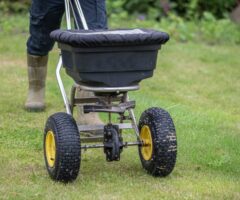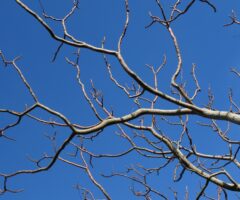Hardy flowering shrubs are truly the backbone of a mixed perennial border, contributing texture, color, and structure to a garden. Adding colorful flowering shrubs to your Mid-Michigan landscape can improve its visual interest, create privacy, attract pollinators, add enchanting scents, and much more. If you’re searching for hardy flowering shrubs that grow well in the Bay City area, check our recommendations below for five rock-star flowering shrubs that will add pizzazz to the landscape.
How to Choose a Flowering Shrub for Mid-Michigan
While it’s easy to grab the first shrub that appeals to you, it helps to know what to look for. Do your research and find hardy shrubs that have easy-to-manage features and will grow well in your landscape. With a little planning, you will be thrilled with the choice for years to come.
Three of the top things to look for are maintenance needs, how the shrub will look in your garden throughout the entire year, and whether or not it’s hardy in your location.
- Low maintenance is best– Look for a shrub that is not only beautiful in bloom but is also low maintenance. Who has time for pest or disease issues and endless pruning?! A little advanced research so that you understand a plant’s maintenance needs can make managing your garden so much easier.
- Extend the seasonal interest – It’s tempting to focus only on a shrub’s blossoms; after all, beautiful flowering shrubs can make a garden look spectacular. But, often, that’s only while they’re in bloom. Planting shrubs that also have attractive foliage can extend your landscape’s season of interest beyond just bloom time.
- Know your garden zone – When choosing a flowering shrub for your landscape, it’s important to understand your USDA Plant Hardiness zone. Make sure any shrub you choose will thrive in our area (not all that are sold in Michigan are fully hardy here). Mid-Michigan regional plant zones stretch from zones 5A through 6b.
Top 5 Hardy Flowering Shrubs for Your Mid-Michigan Landscape
Below is a selection of five gorgeous hardy flowering shrubs that we recommend because they grow well in the Bay City, Saginaw, and Midland areas of Michigan. They have profuse flowers, lovely shape, low maintenance needs, and an extended season of foliage interest.
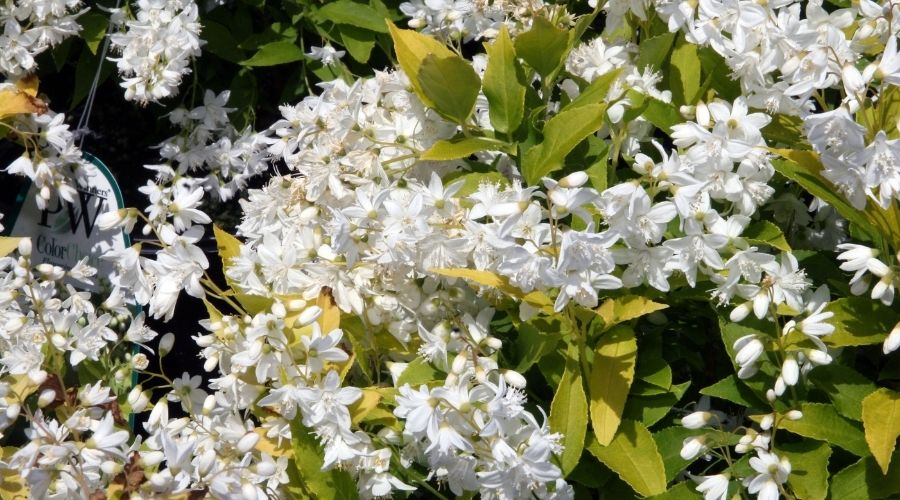
Deutzia Chardonnay Pearls, By Photo by David J. Stang – source: David Stang. First published at ZipcodeZoo.com, CC BY-SA 4.0, https://commons.wikimedia.org/w/index.php?curid=61218496
Deutzia Chardonnay Pearls
Deutzia gracilis ‘Chardonnay Pearls’, also known as Deutzia gracilis ‘Duncan’, is a gorgeous slender deutzia that features tiny, star-shaped pearl-white flowers which are intensely fragrant. The buds look like tiny pearls and flowers on loose racemes in late spring. Blooms show profusely for several weeks.
Bright chartreuse foliage color elevates this freely-branching mounded shrub in the landscape. The lemon-lime foliage makes it an excellent filler shrub and a smart three-season feature.
While this deciduous shrub does wonderfully in most conditions, it will bloom most prolifically in full sun. It prefers well-drained soil. Although it will grow in most soil types, this shrub does best in humusy loam that is consistently moist.
This is a delightful shrub that is perfect in shrub borders or used as an informal hedge. Reaching three-foot by three-foot, it doesn’t need frequent pruning to keep it in bounds. But when it does need a trim, prune it immediately after flowering. The blooms appear on old wood (stems formed the previous year) so if you prune too early you’ll lose all the flowers.
Companion plants for consideration with this attractive deutzia include Lady’s Mantle, Cranesbill, and Catmint.
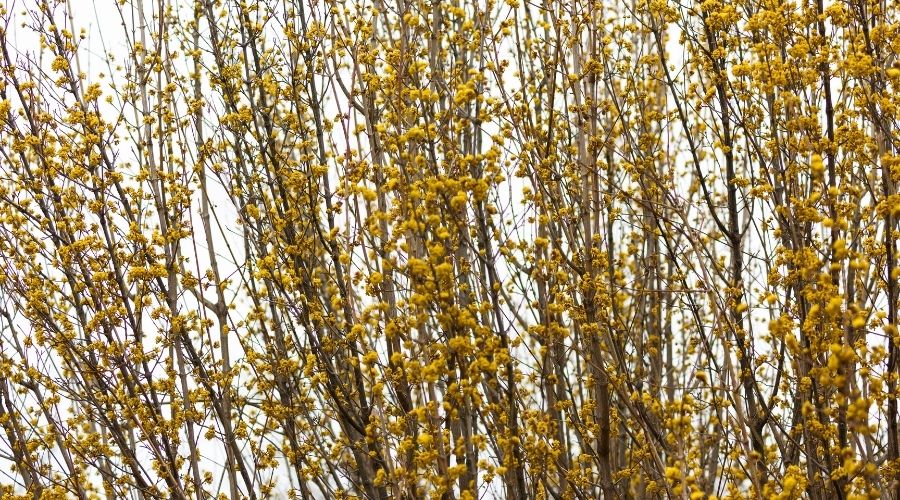
Forsythia Gold Tide
Forsythia Gold Tide, or Forsythia x ‘Courtasol’, is a dwarf forsythia that is heavy with golden yellow flowers. It is typically the harbinger of the spring season and is often the first shrub to bloom in early spring.
Gold Tide is a unique spreading form of forsythia that is more compact than the typical varieties, growing up to two feet high and four feet wide. It has medium green leaves and flowers profusely in spring. It is also quite attractive from summer through fall, although the shrub has unremarkable fall color.
Forsythia grows well in rich, loose soil, but is often quite adaptable as long as the soil is well-draining. Although fairly drought tolerant after it is established, Gold Tide needs regular water during hot summers. Plant it in full sun to filtered sun.
If pruning is needed, do so immediately following the flower season. Old stems from the shrub can be cut all the way to the ground, making way for new, more vigorous growth.
Gold Tide looks gorgeous in a cottage garden, woodland garden, or as mass planting. Companion plants that work well with this shrub include daffodils, hyacinth, and other spring-flowering bulbs.
Because of its compact size, it also grows very well in containers. The yellow flowers of this shrub are particularly striking planted in containers from our AquaPots Ultra Marine Smooth Collection.

Korean Spice Viburnum
Korean Spice Viburnum (Viburnum carlesii) is a versatile shrub that works equally well as a foundation planting or specimen. Named for its scent, Koreanspice has a heady over-the-top fragrance.
Growing four to six feet tall and four to seven feet wide, this plant is considered a medium-sized shrub.
Buds erupt pink, then evolve into white,three-inch-wide snowball clusters the tips of stems. Standing near the plant will have you awash in the absolutely intoxicating spicy scent of the flowers. Flowers give way to bold, oval-shaped red drupes borne in clusters. These fruits ripen to black in late summer and are a favorite of local birds.
The foliage is approximately four inches wide at the base, tapering to a point, and serrated along the edges. Leaves emerge copper-colored, but mature to dark green. Autumnal foliage is a burgundy red.
Plant it near high traffic areas so guests to the garden can enjoy the amazing scent and bold colors of this shrub.
Koreanspice viburnum is easy to grow in average well-drained soil with medium moisture. Although the shrub will tolerate partial shade, it flowers best when planted in full sun. It’s also one of the few shrubs that will tolerate growing near a black walnut tree.
It is important to prune immediately following the flowering because blooms appear on old wood.
Korean spice viburnum makes an excellent shrub border, hedge, or foundation plant, and also looks lovely when planted in groups. If you’re interested in attracting birds or pollinators to your garden, this shrub would be a good choice. Excellent companion partners include Coralbells, Geranium, and low-growing groundcovers.
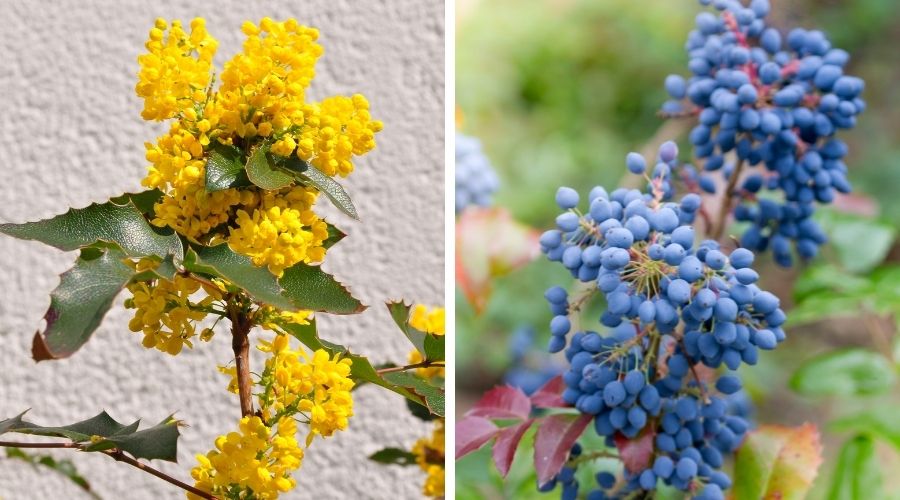
Mahonia ‘Oregon Grape Holly’
Oregon Grape Holly, or Mahonia aquifolium ‘Oregon Grape Holly’, is a spectacular broadleaf evergreen shrub with year-round interest. Bright yellow flowers appear just above leaves near the end of stems. Pollinators love the blooms, which are lightly fragrant. The flower is well-loved as the state flower of Oregon. Deep blue edible berries make a show in late summer after flowering. Birds and wildlife adore the fruit, which can be made into a delicious jelly.
Oregon Grape Holly provides interest throughout the winter due to its unique leathery, holly-like foliage. Leaves emerge a deep bronze-red in spring, mature to green, then turn a bold burgundy in the autumn. The long-lasting foliage makes a nice addition to cut flower arrangements.
Preferring part shade to full shade, the Oregon Grape Holly does not tolerate full sun. Plant it in organically rich, acidic, well-drained soil that is consistently moist. For best fruit production, plant several shrubs as a group to aid pollination.
As a shade-lover, this shrub works well in woodland gardens, cottage gardens, or traditional beds and borders. It needs enough room to spread, growing three to six feet high and wide. Companion plants for consideration with mahonia include Siberian Bugloss, Cranesbill, and shady groundcovers.
One important concern with this shrub is that it can rapidly form colonies by suckers. Removing suckers as soon as they develop will keep the shrub in bounds.
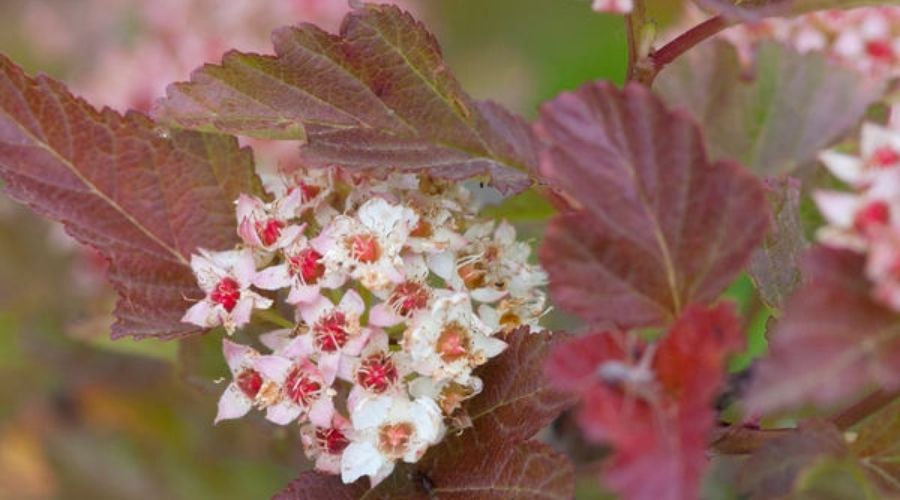
Ninebark ‘Amber Jubilee’ has year-round colorful foliage and beautiful spring blooms.
Ninebark ‘Amber Jubilee’
The Ninebark Amber Jubilee (Physocarpusopulifolius ‘Jefam’) is a colorful variety of ninebark. Beneficially, it is less likely to spread via root suckering as compared to other varieties of ninebark. Amber Jubilee is a great pollinator shrub that attracts butterflies and offers spectacular four-season interest.
Flower buds are pink, then mature into tiny clustered white flowers with pale yellow centers. Butterflies adore the flower, which makes this shrub a great addition to a pollinator landscape. Mature stems have peeling bark for winter interest. It can grow five to seven feet high and four to six feet wide.
As a spectacular color display, Ninebark Amber Jubilee is over-the-top amazing. Surprisingly, it is the multi-lobed foliage that gives the shrub its seasonal color instead of the flowers. In the spring, the foliage emerges purple but soon changes in color to red, orange, and yellow. Once the weather warms in summer, the leaves look like they have been touched with a paintbrush dipped in lime green paint. Autumn colors are a return to the deep red, orange, and yellow.
Amber Jubilee grows best in average soil that is slightly acidic and well-draining. It prefers medium moisture and sun to part shade conditions. In Mid-Michigan, Amber Jubilee develops its best color in full sun. When needed, prune immediately following bloom. Should a rejuvenation prune be necessary, cut off the stems very close to the ground.
A very easy shrub to grow, Amber Jubilee is best placed where it has room to spread as a feature plant in landscapes, cottage gardens, or mixed borders. It’s particularly effective when planted as a companion plant with woodland plants and other pollinator-loving shrubs and perennials.
Ready to Plant Hardy Flowering Shrubs?
These five shrubs will grow easily in Mid-Michigan. They offer multiple seasons of interest, easy management, and fantastic bloom power for your garden. You can find all five of them at the Bay Landscaping nursery in Essexville, Michigan.
It’s best to plant hardy flowering shrubs in spring or fall. Be sure to follow our tips for new plant maintenance to give your new shrubs the best chance for success.
If you have questions about shrubs or shrub planting, contact us for an appointment. We can recommend, source, and plant the best shrubs for your property.





